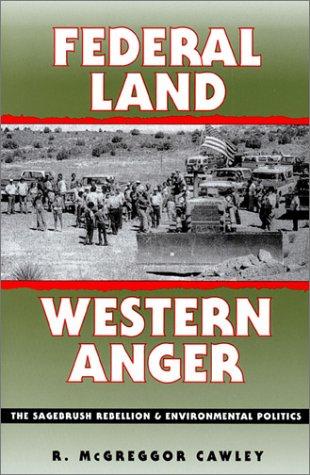
The April issue of The Forestry Source, leads off with “The Sagebrush Rebellion Renewed: Bills Aim to Create Trusts to Manage Federal Timber,” by Steve Wilent, Forestry Source editor. The article begins with what I perceive to be a very narrow view of the origins of the 1980s Sagebrush Rebellion, blaming it all on “environmentalists”. The article ends with what I perceive to be cheerleading for “forest trusts” as a solution to current problems including the impending drying up of “Secure Rural Schools and Community Self-Determination Act” funding. It is an opinion-editorial, so Wilent is entitled to his perspective. But I thought I’d share it with you, since my own framing of this matter is much different. I see the 1980s Sagebrush Rebellion being just one of many from a West that was always angry over public lands. In my frame, fully funding Payments in Lieu of Taxes is a better solution to the rural schools problem. And I find the “forests trusts” idea a non-starter in dealing with America’s national forests.
Wilent’s article begins:
In his 1993 book, Federal Land, Western Anger R. McGregor Cawley describes the Sagebrush Rebellion as “a protest originating from three interrelated perceptions: first, that environmentalists had succeeded in gaining a dominant position in federal land policy discussions; second that the environmental community’s influence had created an underlying bias in favor of preservation over development in federal land management decisions throughout the 1970s; and third, that the only way to counteract the increasingly restrictive character of federal land management decisions was to precipitate an open confrontation.”
The first shot in that confrontation was fired in 1979, when the Nevada state legislature passed a bill that sought to transfer control of 40 million acres managed by the US Bureau of Land Management (BLM) – about 79% of Nevada – to the state. …
In February, Utah fired a new salvo when its house of representative passed the Transfer of Public Lands Act….
My own framing, built in part off the Public Land Law Review Commission’s “History of Public Land Law Development”, here, tracks the Sagebrush Rebellions (several of them, with continued skirmishes in between) back to the fights for statehood in the USA. In my state of Utah the fight was nasty and long-standing. Some Utahan’s were mad back then and continue to be mad today, with their anger welling-up periodically. Ron Arnold may have captured the spirit of that 1980s “Rebellion” as well as did the Society of American Foresters (SAF) article, calling it “a temper-tantrum over public lands thrown by a handful of cowboys”. That “temper-tantrum” turned into yet-another bandwagon that powerful rural Western politicians could jump onto—which they ultimately parlayed into substantial gains. Here is what Frank J. Popper had to say about these “gains” in “A Timely End of the Sagebrush Rebellion” (pdf), National Affairs 76, Summer 1984.
The Sagebrush Rebellion did not fail—it ended because it achieved many of its goals. The Reagan administration rapidly found clever, politically appealing ways to start to transfer some public lands without having to ask Congress for new legislation. Watt’s Interior Department undertook a “good neighbor policy” that allowed state and local governments to request the department’s “surplus” lands. The initiative was soon broadened to an Asset Management Program whereby all federal agencies could sell their excess land in the West and elsewhere; the eventual sale of 35 million acres–an area the size of Iowa–was expected. Separately, the Forest Service prepared to sell up to 17 million acres. The federal land agencies sped up the transfers to Alaska’s state government and Native Americans authorized by the 1958 Statehood Act, the 1971 Native Claims Settlement Act, and the 1980 National Interest Lands Conservation Act. The BLM experimentally revived homesteading in the Kuskokwim Mountains in central Alaska. Numerous federal-Western state land exchanges were in exploratory stages, and seemed most advanced in Utah. [p. 68]
Another look at the 1980s Sagebrush Rebellion, from “A Brief History of the Anti-conservation Movement” frames the issues as conservatives v. liberals:
At its most basic level the Sagebrush Rebellion was a conservative backlash against the growth of federal power represented by, among other things, such landmark environmental legislation of the late 1960s and ’70s as the National Environmental Policy Act (NEPA), the Clean Air Act, the Clean Water Act and the Endangered Species Act. These legislative programs created new roles and concerns for managers of federal land — protection of endangered species, water quality, air quality, etc. This required closer scrutiny of activities on federal lands, including the activities of miners, loggers and ranchers who operated there. Significantly, these businesses usually enjoyed substantial operating subsidies by virtue of longstanding below-market rates for grazing, mineral and timber rights on federal land. This closer scrutiny inevitably led to federally imposed restrictions when mining, grazing and foresting practices damaged the water and air and threatened endangered species. Recognizing that a return to the good old days of less regulation would be good for business, the movement took support and comfort from the 1980 election of Ronald Reagan, one of whose campaign planks was reduction of the size and power of government. Certain Reagan cabinet appointees, most notably James Watt as Secretary of the Interior and Anne Gorsuch as head of the Environmental Protection Agency, were selected in part for their willingness to further the de-regulatory agenda of Reagan and the right wing of the Republican Party. …
The Anti-Conservation Movement further benefitted from the attention it received from industries with something to gain. In particular, big agriculture (the American Farm Bureau Federation, The Cattlemen’s Association), the extractive industries (mining, including coal, oil and gas) and timber producers (who thrive on easy access to federal forest lands) saw a reduction of federal regulatory power working to their advantage. This message of the economic benefit of deregulation appealed as well to small businesses. After all, if workplace safety regulations could be reduced or eliminated, the money saved could be plowed back into the business.
During this period anti-regulatory forces sought to define and project an agenda that would be publicly acceptable. Throughout the 1980s the anti-regulatory/anti-environmental sentiment was expressed largely as support for the Reagan Revolution and its promise to deliver the country from the clutches of over-zealous, regulation-happy bureaucrats.
In studying the various Sagebrush Rebellions we would all probably benefit from a good class on the history of the American West. Here is one (pdf, syllabus) from Professor Chris Lewis, from the University of Colorado. Lewis places Cawley’s book in a class lecture on “‘The Lords of Yesterday’ and the Sagebrush Rebellion”. The book is well-placed there, since it is evidently written from the perspective of ‘the rebels’, according to a Great Plains Research book review (pdf). There is nothing wrong with that. One of my favorite books is Howard Zinn’s A People’s History of the United States, which is unabashedly written from the perspective of those who lost (and/or who were horrible abused) in the struggles to form the United States. Zinn acknowledges his bias, but is quick to note that no “history” is written without bias. But what is wrong with Wilent’s piece, in my opinion, is to use the book to suggest that one particular perspective is the only perspective that counts. Still, opinion/editorial pieces often do that. So, I’ll just leave it at, “I beg to differ”.
Wilent’s article goes on to highlight various ongoing problems including the impending falldown in Secure Rural Schools and Community Self Determination Act funding—problems which are clearly still with us. These problems don’t necessarily cry out for the solutions that are being proffered in the various bills currently working their way through Congress. But you wouldn’t arrive at that particular conclusion from Wilent’s article, which concludes by essentially cheerleading attempts to put federal land management into “land trusts.” “Cheerleading” is how I see it. What Wilent actually said was this: “Management by a trust dedicated to maintaining revenues to schools and other beneficiaries may offer a solution. …”
Wilent didn’t bother to daylight any other “solutions.” So cheerleading is where I’ll leave it. When dealing with ‘trusts’ my question is, as has been for a long time, “Land trusts provide a solution to what?” Yes land trusts are a good way to generate revenue if that is all you are interested in. But I thought that the ‘public trust doctrine’, under which the national forests were carved out and managed, is much broader than ‘revenue generation’. And we are not living in 1900, when income taxes and other revenue generation means now available to the federal government were not established.
In the middle of Wilent’s article, John Freemuth is quoted on both the complexity of federal lands management and his desire to reconvene a Public Lands Law Review Commission. I support Freemuth’s desire. On the other hand, I’m pretty sure that just about no one who is ranting and raving in this (or the last) Sagebrush Rebellion has ever read the last Public Lands Law Review Commission Report. Why should we expect a new one to add value to this debacle? Still, I would like to see a new one, if only to force the Administration and the Congress to delve deeper into the issues (and the history) surrounding our “Angry West”. But I’m not sure that a re-reading of the original Public Lands Law Review Commission Report wouldn’t suffice to dispel myths surrounding each seemingly-novel episode when the American West, particularly the “rural West” explodes anew in yet-another “temper-tantrum.” I guess we all get to pick our frames, and our scapegoats.
Related NCFP Posts:
Free America From Her Public Lands?
Utah’s Sagebrush Rebellion Awakens
The Frame Game
The Blame Game



